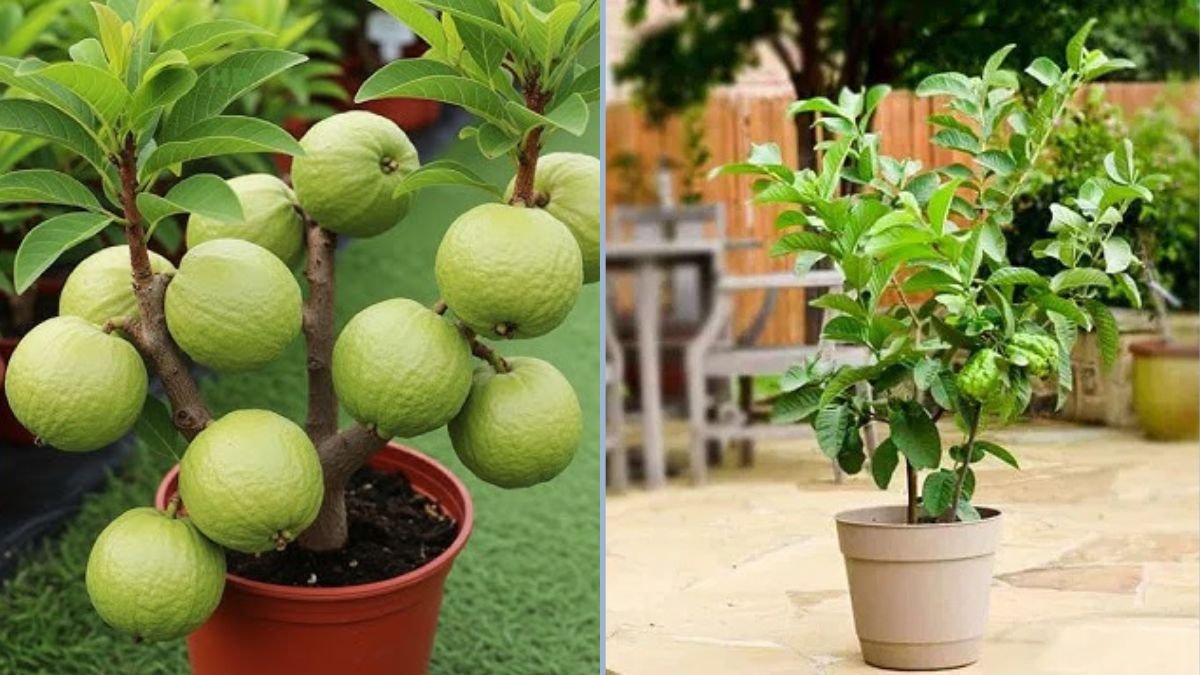Guava is one of the most popular tropical fruits, loved for its sweet aroma, nutritious value, and delicious flavor. While traditionally grown in gardens or orchards, guava trees can also thrive in pots, making it accessible for urban gardeners, apartment dwellers, and families without large outdoor spaces.
Growing guava in a pot not only allows you to enjoy fresh fruits at home, but also gives you better control over soil, water, and sunlight. In this guide, we’ll show you how to grow a guava tree faster in a pot, care for it, and eventually harvest healthy fruits.
1. Why Grow Guava in a Pot?
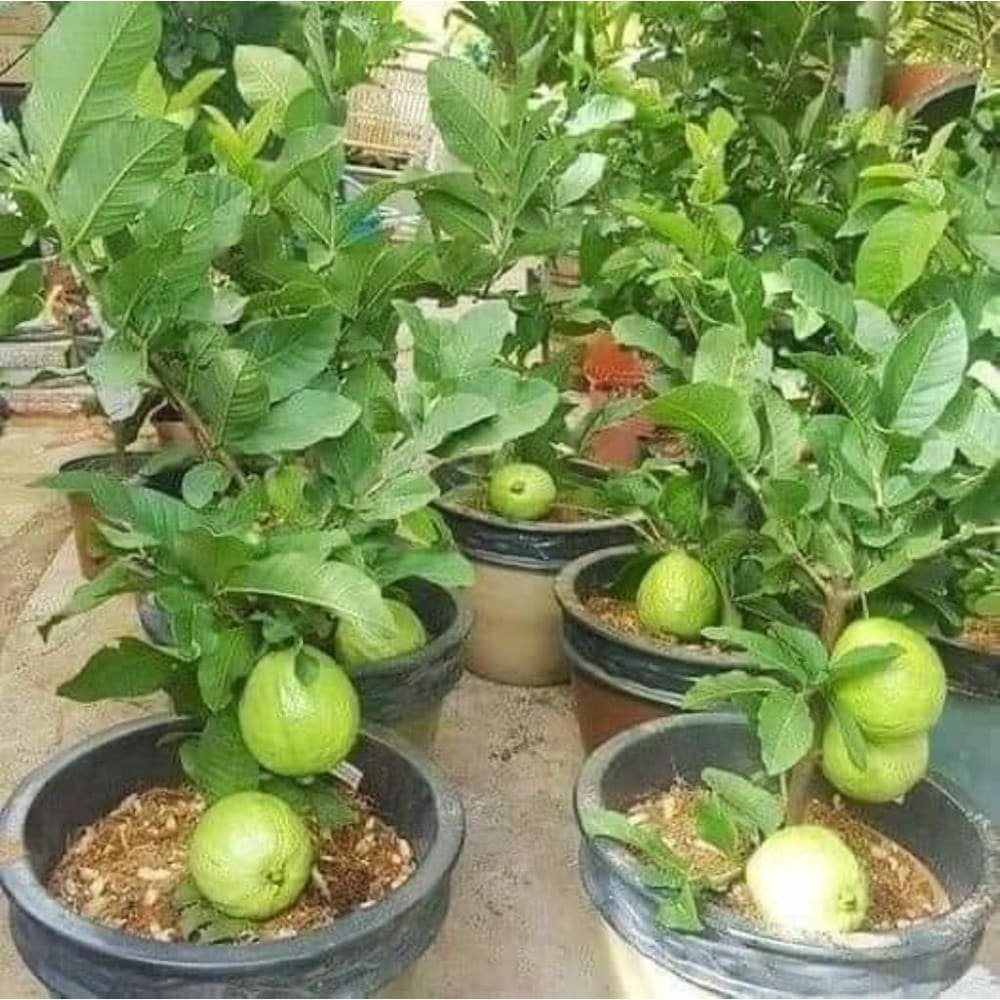
Container cultivation of guava offers several advantages:
- Space-saving: Ideal for balconies, terraces, and patios.
- Mobility: Move the plant to optimize sunlight or protect it from harsh weather.
- Soil control: Ensure well-draining, nutrient-rich soil for optimal growth.
- Pest management: Easier to monitor and treat pests.
- Faster growth potential: With proper care, container-grown guavas can grow quickly and fruit earlier.
Growing guava in pots is perfect for gardeners who want fresh fruits without a traditional garden.
2. Choosing the Right Guava Variety
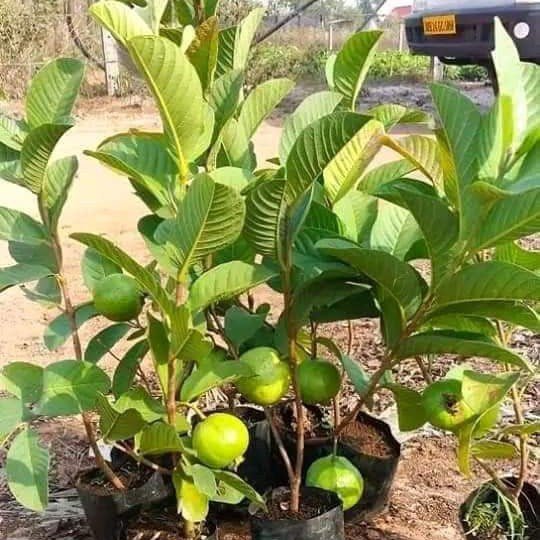
Selecting the right guava variety is crucial for pot cultivation:
Recommended pot-friendly guava varieties:
- Allahabad Safeda: Popular for sweet, aromatic fruits and fast growth.
- Lucknow-49: Medium-sized fruits with high yield.
- Dwarf varieties: Ideal for container growth, early fruiting, and manageable size.
Choosing the right variety ensures faster growth, better fruiting, and easier maintenance.
3. Selecting Seeds or Seedlings
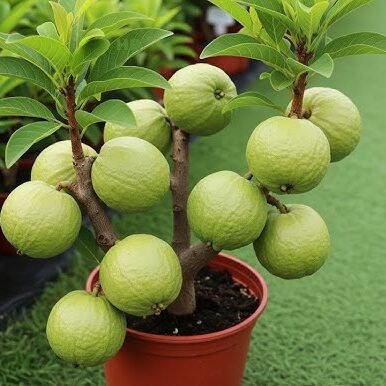
You can grow guava from seeds or saplings:
- Seeds: Extract seeds from ripe guava, clean them, and dry for 1–2 days before planting. Seeds may take longer to fruit but are cost-effective.
- Saplings: Young plants from nurseries give faster growth and earlier fruiting.
💡 Tip: For faster growth and fruiting, using a healthy sapling is recommended.
4. Choosing the Right Pot
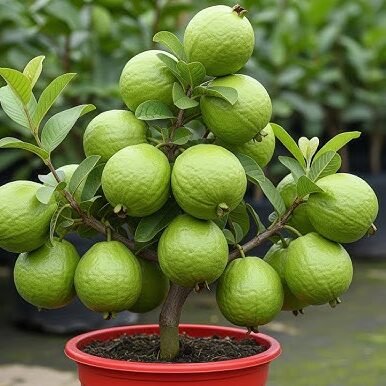
Container selection is critical for guava growth:
- Size: Minimum 18–24 inches in diameter and depth for young saplings; larger for mature trees.
- Material: Plastic, ceramic, or terracotta pots. Terracotta allows better aeration but dries faster.
- Drainage: Ensure multiple drainage holes to prevent waterlogging.
- Mobility: Lightweight pots allow easy relocation for sunlight or protection.
A suitable container ensures healthy root development and faster growth.
5. Preparing the Soil Mix
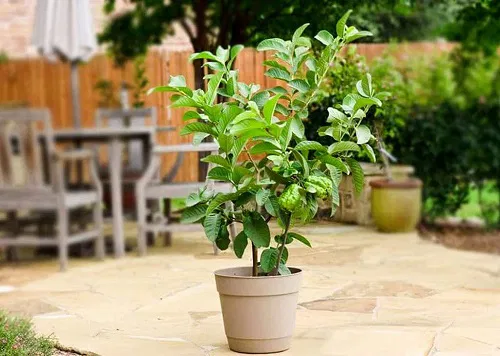
Guava grows best in well-draining, fertile soil:
Recommended soil mix:
- 40% garden soil or topsoil
- 30% compost or well-rotted manure
- 20% coco peat or peat moss for moisture retention
- 10% perlite or coarse sand for aeration
💡 Tip: Avoid heavy clay soil, which can retain excess water and cause root rot.
6. Planting Guava in a Pot
Follow these steps for successful planting:
- Fill the pot halfway with prepared soil mix.
- Place the sapling or germinated seed in the center.
- Fill soil around the roots, pressing lightly to remove air pockets.
- Water lightly to settle the soil.
- Place the pot in bright sunlight, ideally 6–8 hours daily.
Proper planting ensures strong roots and faster establishment.
7. Sunlight and Temperature Requirements
Guava is a sun-loving tropical plant:
- Sunlight: 6–8 hours of direct sunlight daily.
- Temperature: Optimal range is 20–30°C (68–86°F). Protect young plants from frost.
- Air circulation: Adequate airflow reduces fungal infections and promotes healthy growth.
Providing the right environment ensures faster growth and strong branches.
8. Watering Guava Plants
Proper watering is essential for container-grown guava:
- Keep soil moist but not waterlogged.
- Water deeply 2–3 times per week, adjusting for weather conditions.
- Reduce watering in winter when growth slows.
- Mulch the soil surface to retain moisture and maintain temperature.
Consistent watering supports vigorous growth and early fruiting.
9. Fertilizing Guava for Faster Growth
Fertilization accelerates guava growth:
- Use a balanced fertilizer (NPK 10:10:10) during the vegetative stage.
- Apply a potassium-rich fertilizer during flowering to enhance fruit set.
- Fertilize every 4–6 weeks during the growing season.
💡 Tip: Avoid excessive nitrogen, which promotes leaf growth over fruiting.
10. Supporting Guava in a Pot
Container-grown guava trees may need support as they grow:
- Use a stake or bamboo support for young trees to maintain upright growth.
- Tie branches loosely to prevent breakage in wind or heavy fruiting.
- Train lateral branches for a bushier growth habit.
Proper support ensures healthy structure and stronger branches for fruit production.
11. Pruning Guava for Faster Growth and Fruit
Pruning helps stimulate growth and improve fruiting:
- Remove weak, damaged, or overcrowded branches.
- Trim the top to encourage bushy growth and lateral branches.
- Prune after harvesting to prepare for the next flowering cycle.
Well-pruned guava trees grow faster, produce more fruits, and resist diseases better.
12. Flowering and Pollination
Guava plants produce fragrant flowers that attract pollinators:
- Most varieties are self-pollinating, but cross-pollination can improve fruit size.
- Bees and other insects enhance pollination naturally.
- Hand pollination is possible for indoor or balcony plants to boost fruit set.
Proper pollination ensures early and abundant fruiting.
13. Harvesting Guava Fruits
Patience is key — container-grown guava trees may take 1–2 years to bear fruit:
- Fruits are ready when they reach full size and change color depending on the variety (green to yellow or pinkish).
- Twist or cut fruits gently to avoid damaging branches.
- Frequent harvesting encourages continued flowering and fruiting.
Homegrown guavas are sweet, juicy, and packed with vitamins.
14. Common Pests and Diseases
Guava in containers is relatively hardy but can face issues:
- Fruit flies: Cover fruits with protective bags.
- Aphids and mealybugs: Spray neem oil or insecticidal soap.
- Fungal infections: Avoid waterlogging and ensure proper airflow.
Regular monitoring ensures healthy growth and high-quality fruits.
15. Long-Term Care of Guava in Pots
For long-term success:
- Repot into larger containers every 2–3 years to accommodate root growth.
- Mulch and fertilize seasonally to sustain growth and flowering.
- Maintain support and prune annually for a strong, bushy structure.
With consistent care, container-grown guava trees can produce fruits for many years, making them ideal for home gardeners.
16. Final Thoughts: Growing Guava Faster in Pots
Growing guava in a pot is practical, rewarding, and space-efficient. By selecting healthy saplings, preparing well-draining soil, providing proper sunlight, water, support, and fertilization, you can grow a guava tree faster and enjoy fresh fruits at home.
Container gardening allows urban households to experience the joy of fruit cultivation, even without a traditional garden. With patience and consistent care, your potted guava tree can flourish, producing abundant, delicious fruits for your family.
Growing guava in pots is the perfect solution for home gardeners seeking fresh fruits without needing a large garden. By following this step-by-step guide, you can cultivate a healthy, fast-growing guava tree and enjoy its fruits in the comfort of your own home.
